TLDR:
This was my first race since having prostate surgery 6 months ago. During this time I’ve trained hard to get back into race-shape and looked forward to testing myself at this Olympic distance triathlon. The time had arrived to face my fears and go all-out with a do-or-die mentality. Fortunately, I succeeded and broke my personal best time by about 40 minutes. I also made some mistakes and suffered from dehydration and sodium depletion because I was too slack with my race-day hydration & nutrition. The bottom line is that the race was a wild success and I’ve learned some valuable lessons.
Full race report:
I learned about this race two years ago and the Olympic distance seemed like fun. At the time, the thought of racing that distance was intimidating; I’ve come to view Olympic distances as short, fun races. I’m not intimidated by them at all. The challenge is how quickly I can do them because they are not endurance races, yet, they are not truly sprints either. They are just long enough that going all out should take me to my limit of sustained maximal effort.
Therein lies the appeal
I decided that this race was an opportunity to face performance fears and go all out to see what I was really capable of achieving. Going to the next level of racing is what I want. To do that, I have to challenge my self-limiting beliefs and push against mental barriers that cause me to hold back when racing. I asked Johnny what paces and cycling power I should target. He told me none; I should to go full-throttle and redline the whole race. If I’m not huffing and puffing, I’m going too slow. Let them see the engine that you’ve built.
A bolt of electricity shot through me when he said to do that. In addition to the coach’s green light, I had the internal desire to let loose! The junkyard dog was awake!
Bike check-in and packet pickup
We drove to Austin on Sunday afternoon so that I could drop off my bike and pick up my athlete packet. They dropped me off and proceeded to the hotel to take our bags to the room. As I was picking up my packet, the sky became dark and it began raining cats and dogs. Initially, I waited on the porch of the registration building, then thought, fuck it. Am I going to stand here all evening because of the rain? Fuck No!
I walked over to the transition area, dropped off my bike, and then walked to the hotel so we could get some dinner. As I left the bike corral, I felt a surge of excitement. Racking my bike in the rain, seeing the competitors, and thinking about the race were all that I needed to stoke the flames of aggression and the desire to compete.Since I had to be in transition by 5:30 am, I decided to organize my gear bags after I took a #flatbruce photo. Before turning in Robin and I discussed my time goals.
Finish the race in 2 hr 40 min.- Complete the 1500 meter swim in less than min (~1:40/100 yds pace)
- Complete the 25-mile bike in 1 hr 07 min (22.4 mph average)
- Complete the 10K run in 50 min (8:20 / mile average) <== My stretch goal
I believed that all of those times were achievable. I felt the most uncomfortable about being able to sustain an 8:20/mile pace for 6 miles, but the goal was to sustain “uncomfortable”.
Race Morning
At 5:00 am I was up and making a bowl of Picky Oats oatmeal. I wanted to put some food on my stomach that would serve as fuel through the race. I planned to use infinite and some SIS energy gels along the way; the oatmeal would be my base. I went to transition soon after it opened because I don’t like the feeling of being rushed before the race begins. The process of setting up the gear for each discipline takes some thought and if I’m feeling stressed I’ll miss something important.
After feeling confident that my gear was set up and ready to go, I took a walk around transition to see who was there. I knew that there a few of my fellow Pearland Triathlon Racing Club members were in attendance. I saw Hai Nguyen who was racked next to Robert Montgomery a few sections away from me. I didn’t see Kyle Stone or Jessely Reed until I was by the river waiting for the swim to begin. Seeing them brought my anxiety down a bit. I’m used to being alone during the races so having some folks to commune with felt great.
The swim sets the tone for my day
It’s a great thing that the swim is the first discipline because I’m the most confident and comfortable doing it compared to the bike and the run. I’m not the fastest, but I’m quite a bit faster than most of my age group. Lake swims are enjoyable and I was happy that the lake was calm this morning. We swam upstream for about 1/3 of the course, then across the width to a buoy and turned and went with the current for the longest stretch of the event, and finally back upstream to the exit. The water was dark (the sun was just beginning to rise) and warm, yet cool enough to be wetsuit legal.
For this race, I decided to start near the front of my age group instead of in the middle or rear like I’ve historically done. If I was going to follow through with putting it all on the line, I knew that starting later in the pack would cause me to have to work harder to navigate swimming past most of my age group. 
The water was refreshing and I felt confident. Using Form Swiim Goggles I was able to monitor my pace during the swim. These things are total game-changers! I noticed that for the first 500 yds I was cruising along at a 1:32/100yd pace; I knew that I could hold it for the full distance. Unfortunately, I didn’t pull my wetsuit all the way up and my shoulders were fighting unnecessary resistance. They were fatiguing faster than normal so I decided to ease into a 1:41/ 100yd pace. I wanted to keep the overall pace as close to 1:40/100 without hurting my shoulders. Also, at about the 500 yd mark, I began swimming past the age group that left before mine. I was passing them and having to navigate more than I wanted. Surprisingly, I found this very motivating although it was more difficult because I had to lift my head to sight more frequently. I was even being hit by some of them who were swimming in a zig-zag pattern. The most violent collision occurred when I got a full-force elbow into my left eye and forehead. It startled the shit out of me, but my goggles didn’t leak and I could still see so I kept going full steam ahead. The chaos of the swim didn’t allow me to focus much on technique. I had to keep an eye out for other swimmers, the buoys, and safety kayaks while trying to swim straight and maintain my pace. In the midst of the swim, I realized that being able to spend hours in a pool focusing on a particular aspect of technique is critical. Doing that allows the development of muscle memory so that when you are in a race the movements happen automatically.
Embarrassingly, I mistakenly thought the swim distance was 1700 meters because my goggles showed that I was at 1500 yd and I wasn’t near the exit. I forgot to convert the distance into meters; I ended up with 1689 yards which are 1544 meters. The effort to reach the distance is the same, but the psychology of perceiving a longer distance negatively affected my effort and how I felt during the last few hundred meters.
All in all, I swam at my desired pace although I think that could have gone faster, but I didn’t feel like fighting the wetsuit. I’ll save it for the next race. Clearly, I made meaningful progress here.Finish time:29 min 29 sec. pace 1:44/100 yds
The cycling leg
After an excellent swim, I was able to get through transition in less than 5 minutes (which was my goal). Breathing hard but not out of breath, I donned my helmet first, then everything else fell into place. As an added precaution I used my Garmin bike computer as a backup to my watch. When I train, I use it to monitor my power, cadence, speed, and distance. As they say, you race what you train, so I raced with the computer.
The weather was good, overcast and humid, but not terribly hot. We rode uphill out of transition along Congress Ave until arriving at the Texas State Capitol building where we made a U-turn and then sped back downhill at 24 mph. Once we got to Cesar Chavez, we had to slow and make a sharp right turn, then it was a long straight ride. My objective was to keep my power above 200 watts with the expectation of averaging 225-240 watts over the ~1hr it should take me to complete the course.
Similar to training days, for the first 15 minutes my cycling legs didn’t feel fully warmed. Once warm, I felt great pushing out 225 W or more. The uphill sections were slower than they should have been, however, I’m not accustomed to hill climbs. My training routes are flat and windy. On the 2nd lap, I noticed a woman who kept passing me on the hills but fell behind me on the straight sections. When we were climbing Congress Ave on the 3rd lap, she said it’s my turn to lead now. I nodded and pulled in behind her to draft for the length of the hill. To ensure that I didn’t get comfortable I made sure to keep my legs burning. The burning was my gauge that I was staying outside of my comfort zone; comfort was the enemy of the day. We played leapfrog for the remainder of the bike course and finished about the same time, but I never saw her on the run course. After the 3rd lap, I became confused and uncertain when to turn off to the finish line. I’d misread the course map and thought that we were to only do 2 laps. But when I saw that we were nowhere near 25 miles after 2 laps, I thought maybe they made an error and we have to do part of a 3rd. Then as we were finishing the 3rd, my computer still showed that we were significantly short of the 25 miles so I became uncertain what to do. As I passed the turn to go to the finish line, I pulled over to the side of the road and began debating how to proceed when the woman that I’d been leap-frogging with yelled one more lap. I jumped back in and tried to make up some time by pushing hard and avoiding any unnecessary coasting. Unfortunately, a heavy rainstorm passed over us halfway into the last lap so I decided to slow down. I knew the roads would get slippery; there were debris and potholes scattered throughout the course and I didn’t want to risk crashing. As I watched some of the more aggressive riders blow past me I began to question if I was making the right choice. In the end, I was comfortable getting to the finish line a little slower so that I could be unharmed and ready for Ironman Lubbock in 1 month.
Overall, the bike leg was a success. I met my goal of averaging over 200 W and 20 mph. My normalized power was 307 watts. I did notice fairly early in the ride that I was favoring my left leg a lot more than the right. As result, the left quad muscle was burning and aching a lot more than the right one so I kept consciously pushing harder with my right foot to balance out the effort. After looking at the data, I was generating 65% of my power with my left leg. I will pay attention to this in training, maintaining a balance is important.
Finish time: 1 hr 13 min. 19.4 mph average speed, 225 W average power, 307 W normalized power.
Sprint to the finish?
Again, I was able to get through transition in under 5 minutes. Historically, when racing a sprint or Olympic tri, my legs are out of commission immediately after riding. The cramping makes it difficult to even walk. Today, they were a little heavy, but I didn’t have any issues with turnover so I jogged out of the run chute eager to push myself for the next 10K. Keeping a cadence of 180 while holding good form were the targets that I thought would help me to sustain a pace in the 8:xx min/mile range.
I started out feeling good at 8:15/mile but knew that I should slow down and let my legs get used to running. Going out too fast after cycling is common because the legs are still in “bicycle” mode. I didn’t want to hit a wall while pushing beyond my comfort zone, so I slowed to about 9:xx min/ mile. By mile 3 I was dragging ass and decided to walk a few steps at one of the aid stations. I also grabbed ice and water to try and cool my body down because I was getting tunnel vision. I also felt lightheaded on occasion which I knew from experience was a sign of dehydration. Although nervous about my condition, I chose to keep pushing as much as I could. Do-or-die was my mantra!
The tunnel vision went away but the lightheaded feeling persisted and my legs were cramping and feeling very heavy. The clock was ticking, and the test was not over. I was determined not to let myself down, so I pushed myself hard to keep a pace in the mid 9:xx / mile. At this point, I knew that my lackadaisical approach to hydration was biting me in the ass and the lesson was being learned in real-time. I even stopped to stretch the cramps out of my quads, but then my hamstrings seized up. So, the only thing I could do was keep moving forward and finish the race. No more thinking about relief, instead, I focused solely on running my race at a pace that was still uncomfortable. Finish the race with no regrets!
My son joined me as I ran through the finisher’s chute – a tradition of ours (unfortunately, Ironman does not allow this). Immediately after stopping, I got lightheaded and the tunnel vision returned. I knew that I’d faint if I didn’t sit down, so I grabbed a few cold water bottles, moved out of the way, and then sat my ass in the grass. My wife and son stood with me and we chatted about the race as I caught my breath. I felt empowered after having the courage to give my all. I didn’t really care if I passed out, I had successfully faced my fears and did what I came to do! I was happy. Run time 57 min 55 sec, 9:41/ mile paceFinal Times
The lessons learned
-
- Hydration – I assumed that I wouldn’t need to be as diligent about my hydration and salt because the race was short(er). Dehydration and electrolyte depletion are serious issues. Being a profuse sweater, I can’t half-ass these two pieces of the puzzle and expect to race well.
- Increase sodium quantity and remain consistent with salt intake while on the course. I haven’t done a sweat test, but I’m confident that I lose a lot of sodium in my sweat.
- The swimming drills are working. I’ve become much more comfortable “feeling” the water. I’m also more attuned to my body position and technique while swimming. Because of that, I can make corrections as my form begins to degrade as I fatigue.
- Cycling activities have made a huge difference in a short amount of time. My legs have become much stronger and I’m able to endure discomfort for longer periods of time.
- I must become a better runner both mentally and physically.
- I think that I could have had a meaningful improvement in my time if I’d been properly hydrated. Getting tunnel vision while running was scary.
- Consider using a stroke timer attached to my swim cap.
- Being in 19th place in my age group feels good.
- I absolutely loved the feeling of racing through the streets with other people. Sometimes I would pick a rider who was moving faster and keep up with them. Other times, I chose to plow past a pack of slower riders.
- I got a surge of delight as I was gliding past other swimmers. Being able to watch my pace in my goggles was an incredible enhancement. Using them made it much easier to hold my pace rather than guess it.
- I am a competitor – embracing that truth feels liberating.
Next up is a week of rest and recovery, then a few weeks to prepare for my first Half Ironman, Ironman Lubbock 70.3

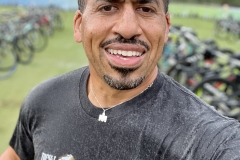
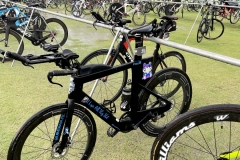
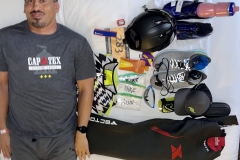
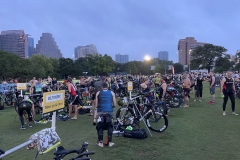


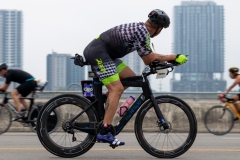

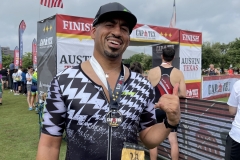
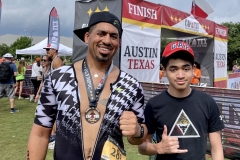
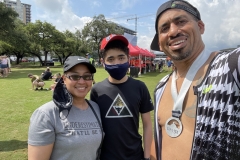





Trackbacks/Pingbacks